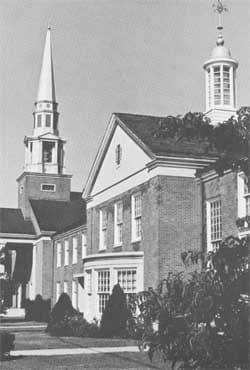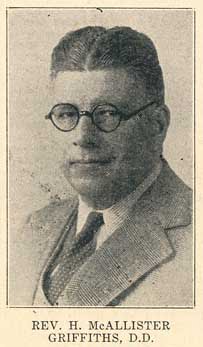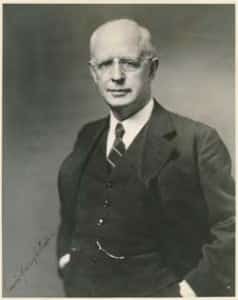One of many conservative Presbyterian responses to the Auburn Affirmation, the following editorial is from the 18 March 1926 issue of The Presbyterian. The editorial comes from the pen of either Rev. David S. Kennedy or Rev. Samuel G. Craig, both men serving as co-editors at that time and the editorial is unsigned. What is noteworthy in this particular editorial is the estimation by the author, in obvious but well-meaning error, that the incursion of modernism into the Presbyterian Church, U.S.A. was not severe.
Are There Two Religions in the Presbyterian Church?
It has long been recognized by leaders of Christian thought that the triumph of Modernism would spell defeat for Christianity. That Modernism and Christianity are diametrically opposed, all along the line, has been set forth most fully and convincingly by Dr. Machen in his well-known book, Christianity and Liberalism. It is not to be supposed, however, that Dr. Machen was the discoverer of this fact : it had found clear and cogent expression long before Dr. Machen had been heard of in the theological world. For instance, as long ago as 1891, Dr. F.L. Patton is on record as saying :
“It seems to me that American Christianity is about to pass through a severe ordeal. It may be a ten years’ conflict, it may be a thirty years’ war ; but it is a conflict in which all Christian churches are concerned. The war will come . . . It is not amendment, it is not revision, it is not re-statement, it is revolution that we shall have to face. The issue will be joined by and by on the essential truth of a miraculous and God-given revelation ; and then we must be ready to fight, and, if need be, to die, in defense of the bloog-bought truths of the common salvation.”
To cite one more instance, it was in 1898 that Dr. Abraham Kuyper said in his Stone Lectures at Princeton :
There is no doubt that Christianity is imperiled by great and serious dangers. Two life systems are wrestling with one another in mortal combat. Modernism is bound to build a world on its own from the data of nature ; while, on the other hand, all those who reverently bend the knee to Christ and worship Him as the Son of the Living God, and God Himself, are bent on saving the Christian heritage. This is the struggle in Europe, this is the struggle in America . . . in which I myself have been spending all my energy for nearly forty years.”
There are comparatively few in Presbyterian circles, we suppose, who would deny that the left wing of Modernism, as represented in this country by men like Kirsopp Lake, A.C. McGiffert, and Shailer Matthews, obviously involves the rejection of historic Christianity ; and none at all, we suppose, who would maintain that such representatives of Modernism should be welcomed into the Presbyterian Church. As far as this left wing of Modernism is concerned, the dictum of the Christian Century is acceptable, we suppose, to practically all Presbyterians :
“Two world-views, two moral ideals, two sets of personal attitudes, have clashed, and it is a cast of ostrich-like intelligence blindly to deny and evade the searching and serious character of the issue. Christianity, according to fundamentalism, is one religion. Christianity, according to modernism, is another religion . . . There is a clash here as profound and as grim as that between Christianity and Confuscianism. Amiable words cannot hide the differences. ‘Blest be the tie’ may be sung until doom’s day, but it cannot bind these two worlds together. The God of the fundamentalist is one God ; the God of the modernist is another. The Christ of the fundamentalist is one Christ ; the Christ of modernism is another. The Bible of fundamentalism is one Bible ; the Bible of modernism is another. The church, the kingdom, the salvation, the consummation of all things — these are one thing to fundamentalists and another thing to modernists.”
But while there are few, if any, in Presbyterian circles who hold that the Presbyterian Church should be “inclusive” enough to include the left wing of Modernism, there are many who confidently maintain that such modernists as are to be found in the Presbyterian Church — practically all of whom belong to the right wing of Modernism — constitute a desirable element that should be retained and, if possible, increased. Dr. Machen’s book, referred to above, has been sharply criticised by a number of Presbyterians. These critics, however, have made little or no effort to disprove his contention that “modern liberalism not only is a different religion from Christianity, but belongs in a totally different class of religions.” They have contented themselves rather with endeavoring to show that the “teachings therein described as characteristic of liberalism are unknown in the Presbyterian Church.” This holds good even of Dr. Merrill. His recent book, Liberal Christianity, is not a defense of Liberalism in general, but rather of the right wing of Liberalism. It is not a defense of the right of modernists in general to call themselves Christians and to remain in the ministry of the Presbyterian Church, but merely the right of modernists like himself to call themselves Christians and to take part in this ministry. No one maintains, as far as we know, that Modernism in its extreme manifestations is prevalent within the Presbyterian Church. When, therefore, the question is asked, “Are There Two Religions in the Presbyterian Church?” what is meant is whether even such Modernism as prevails in the Presbyterian Church has departed so far from Christianity as to be no longer entitled to call itself Christian.
We have already given our reasons for holding that Modernism, even of this less extreme type, is an essentially different type of religion than historic Christianity. We did this with special fulness in our review of Dr. Merrill’s book in our issue of December 3, 1925. They have been given in an abler and more relentless manner by Floyd E. Hamilton, in the current issue of The Princeton Theological Review, as we pointed out in our issue of March 4. Now, if Dr. Merrill’s utterances had met with little or no approval in Presbyterian circles, like, for instance, the utterances of his more radical collegue in Union Theological Seminary, Professor Fagnani, they would afford slight evidence that Modernism has any real foot-hold in the Presbyterian Church. As a matter of fact, however, Dr. Merrill is recognized as a leader by a considerable number of Presbyterian ministers. His book has been praised and commended not only by men like President Stewart, of Auburn Seminary, and Professor Zenos, of McCormick Seminary, but by papers like The Continent and The Presbyterian Advance. The reception his book has received offers obvious proof that Dr. Merrill was not mistaken in thinking that it expresses the faith preached in liberal pulpits ; and, hence, that in many Presbyterian pulpits “another gospel” is being preached. No doubt, all the so-called Modernists in the Presbyterian Church have not departed as far from historic Christianity in their teachings as has Dr. Merrill. Doubtless, some of them have departed further. But be this as it may, it should be obvious to all that even within the Presbyterian Church there is an element that must be extruded if it is to maintain its historic and corporate witness as a Church of the Lord Jesus Christ.
In its issue of March 4, The Continent points to the “Affirmation” of 1923 as proof that “what we have within our Church is not two religions, but two approaches to the great realities of our common faith.” It should not be overlooked, however, that The Continentquotes only one passage of the Affirmation, and that without regard to its context — a deed that does not seem to us altogether ingenuous. The passage cited is the so-called brief creed of the Affirmation :
“We all hold most earnestly to these great facts and doctrines ; we all believe from our hearts that the writers of the Bible were inspired of God ; that Jesus Christ was God manifest in the flesh ; that God was in Christ, reconciling the world unto himself, and that through him we have our redemption ; that, having died for our sins, he rose from the dead and is our everlasting Saviour ; and that in his earthly ministry he wrought many mighty works, and by his vicarious death and unfailing presence his is able to save to the uttermost.”
Now, it must no doubt seem to the ordinary reader that the fact than an Affirmation containing such a creed was signed by men ranked as the most liberal in the Church is conclusive proof that there is essential unity of belief among Presbyterians. That, however, is only because their attention has not been directed to another fact — to wit, that this same Affirmation expressly denies that the inerrancy of the Scriptures, the virgin birth of our Lord, his death as a sacrifice to satisfy divine justice, his bodily resurrection, and his working miracles are “essential doctrines of the Word of God and our Standards” ; and that in the Affirmation itself the brief creed is immediately followed by the statement that “all who hold to these fact and doctrines, whatever theories they may employ to explain them, are worthy of all confidence and fellowship.” In a word, this brief creed, apart from its context, might be subscribed to by every evangelical ; and yet when interpreted in the light of its context, it can be subscribed by no intelligent evangelical. We would not be understood as implying that all the signers of the Affirmation are preachers of “another gospel” — some of them we know signed it under a misapprehension of its meaning — but certainly it offers no disproof of the idea that “we have two religions among us.”
We have no means of knowing the extent to which a religion other than historic Christianity has its representatives in the Presbyterian Church. Not to any great extent, we are disposed to think. It seems obvious, however, not only that there are such, but that their presence is the deepest cause of unrest in the Church.



